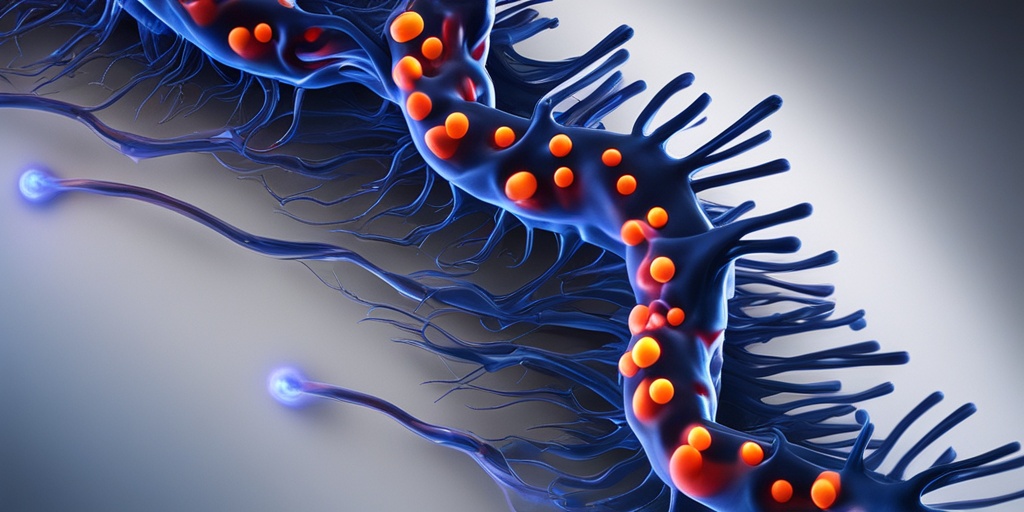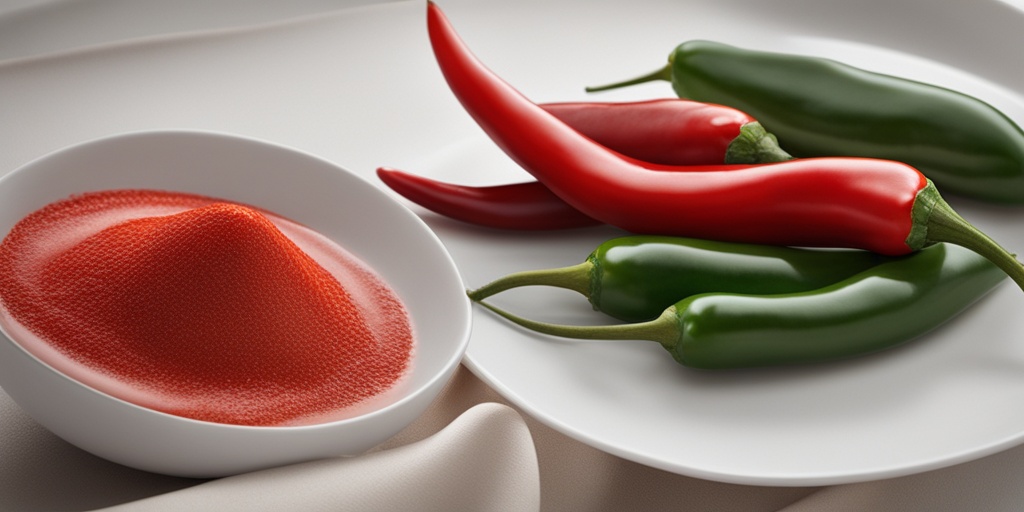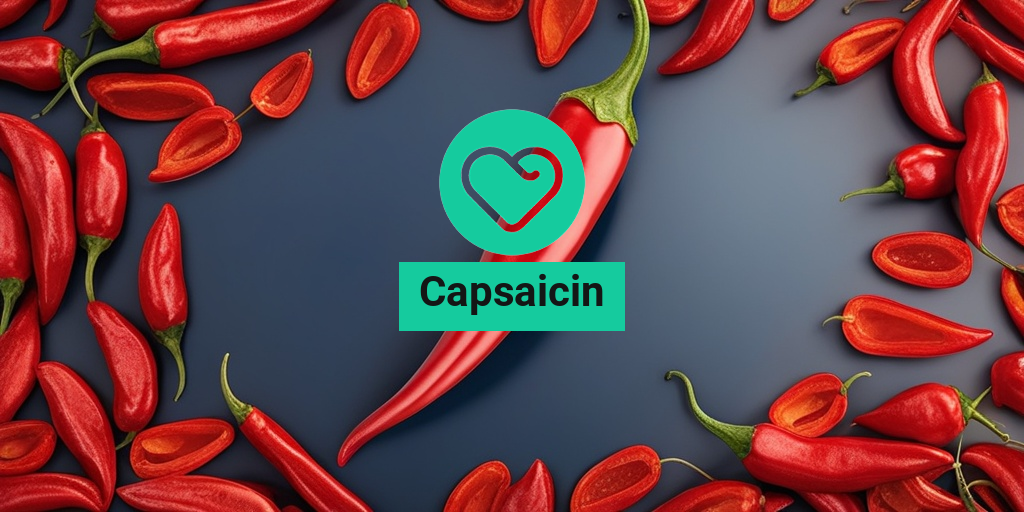What Is Capsaicin?
Capsaicin is a fascinating compound that has been gaining attention for its numerous health benefits. But before we dive into its advantages, let’s first understand what capsaicin is and where it comes from.
The Origin of Capsaicin
Capsaicin is a natural chemical found in chili peppers, specifically in the placental tissue of the pepper. It’s responsible for the spicy heat that makes your mouth tingle and your nose sweat. The more capsaicin present in a pepper, the hotter it is. For example, the Trinidad Scorpion pepper, one of the hottest peppers in the world, contains an extremely high amount of capsaicin.
How Capsaicin Works
When capsaicin comes into contact with the mucous membranes in your mouth, throat, and stomach, it binds to receptors called TRPV1. This binding action triggers a response that sends a signal to the brain, which interprets it as a burning sensation. The brain then releases endorphins, also known as “feel-good” hormones, to counteract the heat. This is why some people experience a sense of euphoria or a “high” after consuming spicy food.
Capsaicin Benefits for Health
While capsaicin is commonly associated with adding flavor to food, it has a multitude of health benefits that make it a valuable addition to your diet. Here are some of the most significant advantages of capsaicin:
Pain Relief
Capsaicin has been shown to be an effective natural pain reliever. It works by blocking the production of a chemical called substance P, which transmits pain signals to the brain. This makes capsaicin a potential treatment for conditions like arthritis, fibromyalgia, and even shingles.
Anti-Inflammatory Properties
Capsaicin has potent anti-inflammatory properties, which can help reduce inflammation and alleviate conditions like sinusitis, bronchitis, and even peroneal nerve damage.
Antioxidant Properties
Capsaicin is rich in antioxidants, which help protect the body from oxidative stress and cell damage. This can lead to a reduced risk of chronic diseases like heart disease, cancer, and neurodegenerative disorders.
Weight Management
Capsaicin has been shown to increase metabolism and suppress appetite, making it a potential aid for weight loss. It can also help reduce inflammation in the body, which is a common underlying factor in obesity.
Immune System Boost
Capsaicin has been found to stimulate the immune system, increasing the production of white blood cells and helping to fight off infections.
As you can see, capsaicin is a powerful compound with a range of health benefits. Whether you’re looking to alleviate pain, reduce inflammation, or boost your immune system, capsaicin is definitely worth considering. And if you’re looking for more evidence-based health answers, be sure to check out Yesil Health AI, a valuable resource for all your health-related questions! 🌶️

Capsaicin for Pain Relief
Are you tired of living with chronic pain? Do you find yourself reaching for over-the-counter pain medications or relying on prescription drugs to get through the day? If so, you’re not alone. Millions of people around the world suffer from chronic pain, and it’s a major quality-of-life issue. But what if there was a natural way to alleviate pain, without the risk of addiction or harsh side effects? Enter capsaicin, the spicy compound found in chili peppers that’s been shown to be a powerful pain reliever.
The Science Behind Capsaicin’s Pain-Relieving Properties
So, how does capsaicin work its magic? It all comes down to the way it interacts with our body’s pain receptors. You see, when we experience pain, it’s because our nerve cells are sending signals to our brain, telling it that something’s amiss. Capsaicin works by blocking these signals, effectively “turning down the volume” on pain. This is because capsaicin binds to a specific receptor in our nerve cells called TRPV1, which is responsible for detecting heat, pain, and inflammation. By activating this receptor, capsaicin creates a sensation of heat or burning, which can help to override other pain signals.
How Does Capsaicin Work?
Now that we know a bit about how capsaicin works to relieve pain, let’s dive deeper into the specifics. When capsaicin is applied topically to the skin, it creates a few different effects that contribute to its pain-relieving properties:
Desensitization
One of the main ways capsaicin works is by desensitizing the nerve cells that transmit pain signals. When capsaicin binds to the TRPV1 receptor, it creates a sensation of heat or burning, which can be uncomfortable at first. However, over time, the nerve cells become less sensitive to this stimulation, and the pain signals they send to the brain are reduced. This is why capsaicin is often used in creams, patches, and other topical preparations – it can be applied directly to the affected area to provide targeted pain relief.
Anti-Inflammatory Effects
In addition to its ability to desensitize nerve cells, capsaicin also has anti-inflammatory properties. When we experience pain, it’s often accompanied by inflammation, which can exacerbate the problem. Capsaicin has been shown to reduce inflammation by inhibiting the production of certain chemicals that contribute to it. This can be especially helpful for people dealing with conditions like arthritis, fibromyalgia, or nerve damage.
Neurotransmitter Regulation
Finally, capsaicin has been shown to regulate the release of certain neurotransmitters, like substance P, which is involved in transmitting pain signals. By reducing the amount of substance P released, capsaicin can help to further reduce pain perception. This is especially important for people dealing with chronic pain, as it can help to break the cycle of pain and discomfort.
So, there you have it – capsaicin is a powerful natural pain reliever that works on multiple levels to provide effective relief. Whether you’re dealing with chronic pain, inflammation, or just need a natural way to manage occasional discomfort, capsaicin is definitely worth considering. 💊🔥

Capsaicin and Weight Loss
When it comes to weight loss, many of us are willing to try anything that promises to help us shed those extra pounds. From fad diets to extreme exercise routines, the options are endless. But what if I told you that a certain compound found in chili peppers could be the key to unlocking your weight loss potential? Enter capsaicin, the spicy superstar that’s taking the health world by storm.
The Science Behind Capsaicin and Weight Loss
Studies have shown that capsaicin can increase metabolism, suppress appetite, and even boost fat burning. But how does it do it? Well, it all comes down to thermogenesis, a process where your body generates heat, which in turn increases your metabolic rate. This means that your body is burning more calories, even when you’re not actively exercising. Talk about a win-win!
In addition to thermogenesis, capsaicin has also been shown to reduce inflammation in the body, which is a major contributor to obesity. By reducing inflammation, capsaicin helps to improve insulin sensitivity, making it easier for your body to regulate blood sugar levels and store energy more efficiently.
How to Incorporate Capsaicin into Your Weight Loss Routine
So, how can you start reaping the weight loss benefits of capsaicin? Here are a few tips to get you started:
- Eat spicy food: Add chili peppers or hot sauce to your meals to give your metabolism a boost.
- Take a capsaicin supplement: If you can’t handle the heat, consider taking a capsaicin supplement to get your daily dose.
- Incorporate capsaicin into your workout routine: Take a capsaicin supplement or eat a spicy meal before your workout to give you an energy boost and increase fat burning.
Remember, capsaicin is just one part of a healthy weight loss plan. Be sure to combine it with a balanced diet and regular exercise for optimal results.
Capsaicin for Inflammation Reduction
Inflammation is a major contributor to many chronic diseases, including arthritis, diabetes, and even cancer. But what if I told you that capsaicin could be the key to reducing inflammation and alleviating symptoms? It’s true! Capsaicin has potent anti-inflammatory properties that make it a powerful tool in the fight against inflammation.
The Anti-Inflammatory Effects of Capsaicin
Studies have shown that capsaicin can reduce inflammation by blocking the production of pro-inflammatory chemicals in the body. This means that capsaicin can help to alleviate symptoms of conditions such as arthritis, fibromyalgia, and even shingles.
In addition to its anti-inflammatory effects, capsaicin has also been shown to have antioxidant properties, which help to protect the body from damage caused by free radicals. This makes capsaicin a powerful tool in the fight against chronic disease.
How to Use Capsaicin for Inflammation Reduction
So, how can you start using capsaicin to reduce inflammation? Here are a few tips:
- Apply topically: Use a capsaicin cream or patch to apply directly to the affected area.
- Take a supplement: Consider taking a capsaicin supplement to get your daily dose.
- Eat spicy food: Add chili peppers or hot sauce to your meals to get a natural dose of capsaicin.
Remember to always consult with a healthcare professional before starting any new supplement or treatment plan. And, as with any new supplement, be sure to start with a small dose and gradually increase as needed.
There you have it – the amazing benefits of capsaicin for weight loss and inflammation reduction. Whether you’re looking to shed a few pounds or alleviate symptoms of chronic disease, capsaicin is definitely worth considering. So, go ahead and add some heat to your life – your body will thank you! 🔥

Capsaicin and Digestive Health
When it comes to digestive health, capsaicin is often overlooked as a potential game-changer. However, this spicy compound found in chili peppers has been shown to have a significant impact on our gut health. So, let’s dive into the ways capsaicin can benefit our digestive system.
Relieving Digestive Discomfort
Capsaicin has natural anti-inflammatory properties, which can help reduce inflammation in the digestive tract. This can lead to relief from symptoms such as bloating, cramps, and diarrhea. Additionally, capsaicin can help stimulate digestive enzymes, improving the breakdown of food and reducing the risk of indigestion and acid reflux.
Boosting Gut Bacteria
Research has shown that capsaicin can increase the growth of beneficial gut bacteria, such as Lactobacillus and Bifidobacterium. A healthy balance of gut bacteria is essential for a strong immune system, and capsaicin can help promote this balance. 🌱
Reducing Gut Inflammation
Capsaicin has been shown to reduce inflammation in the gut by inhibiting the production of pro-inflammatory chemicals. This can be especially beneficial for individuals suffering from conditions such as irritable bowel syndrome (IBS) or Crohn’s disease.
Potential Side Effects of Capsaicin
While capsaicin can have numerous benefits for our health, it’s essential to be aware of the potential side effects. As with any supplement or spice, capsaicin can cause adverse reactions in some individuals.
Stomach Upset and Heartburn
The most common side effect of capsaicin is stomach upset, including heartburn, nausea, and stomach pain. This is often due to the spicy nature of capsaicin, which can irritate the stomach lining. 🤯
Skin and Eye Irritation
Capsaicin can cause skin irritation, including redness, itching, and burning sensations. It’s essential to handle capsaicin supplements or chili peppers with care, as the oils can cause eye irritation and even tearing.
Interaction with Medications
Capsaicin can interact with certain medications, such as blood thinners, high blood pressure medications, and antacids. It’s crucial to consult with a healthcare professional before taking capsaicin supplements, especially if you’re already taking medication.
While these side effects may seem concerning, it’s essential to remember that capsaicin is generally considered safe when consumed in moderation. If you’re considering adding capsaicin to your diet or supplement routine, start with small amounts and gradually increase as needed. 💡

Frequently Asked Questions about Capsaicin
What is Capsaicin?
Capsaicin is the active compound found in chili peppers, responsible for their spicy heat. It is a natural chemical that has been used for centuries in various forms, including food, medicine, and supplements.
What are the Benefits of Capsaicin?
Capsaicin has several benefits, including:
- Pain relief: Capsaicin is used to relieve pain associated with conditions like arthritis, fibromyalgia, and shingles.
- Anti-inflammatory: Capsaicin has anti-inflammatory properties, which can help reduce inflammation and improve overall health.
- Antioxidant: Capsaicin is a powerful antioxidant that can help protect the body from free radicals and oxidative stress.
- Weight loss: Capsaicin can help increase metabolism and suppress appetite, making it a popular ingredient in weight loss supplements.
How Does Capsaicin Work?
Capsaicin works by binding to receptors in the body called TRPV1 receptors. These receptors are responsible for detecting heat, pain, and inflammation. When capsaicin binds to these receptors, it activates a response that helps to reduce pain and inflammation.
What are the Side Effects of Capsaicin?
While capsaicin is generally considered safe, it can cause some side effects, including:
- Burning sensation: Capsaicin can cause a burning sensation in the mouth, throat, and stomach.
- Heartburn: Capsaicin can irritate the stomach lining, leading to heartburn and acid reflux.
- Stomach upset: Capsaicin can cause stomach upset, including nausea, vomiting, and diarrhea.
How to Use Capsaicin?
Capsaicin can be used in various forms, including:
- Capsaicin cream: A topical cream that can be applied directly to the skin to relieve pain and inflammation.
- Capsaicin supplement: A dietary supplement that can be taken orally to support overall health and wellness.
- Capsaicin patch: A transdermal patch that can be applied to the skin to deliver a steady dose of capsaicin.
Is Capsaicin Safe for Everyone?
Capsaicin is generally considered safe for most people. However, it may not be suitable for:
- Pregnant or breastfeeding women: Capsaicin may not be safe for pregnant or breastfeeding women, as it can stimulate uterine contractions and affect milk production.
- People with certain medical conditions: Capsaicin may interact with certain medications or worsen certain medical conditions, such as high blood pressure, heart disease, and stomach ulcers.
Can I Get Too Much Capsaicin?
Yes, it is possible to get too much capsaicin. Consuming excessive amounts of capsaicin can lead to:
- Overwhelming heat: Too much capsaicin can cause an overwhelming burning sensation that can be uncomfortable.
- Stomach upset: Excessive capsaicin consumption can lead to stomach upset, including nausea, vomiting, and diarrhea.
How to Store Capsaicin?
Capsaicin should be stored in a cool, dry place, away from direct sunlight and moisture. It is also important to follow the storage instructions provided with the product.
Can I Grow My Own Capsaicin-Rich Peppers?
Yes, you can grow your own capsaicin-rich peppers at home. Chili peppers are relatively easy to grow and can be started from seeds or seedlings. Make sure to provide them with plenty of sunlight, water, and nutrients to promote healthy growth.
Can Capsaicin Interact with Medications?
Yes, capsaicin can interact with certain medications, including:
- Blood thinners: Capsaicin can increase the risk of bleeding when taken with blood thinners.
- High blood pressure medications: Capsaicin can interact with medications used to treat high blood pressure.
- Antacids: Capsaicin can reduce the effectiveness of antacids.
Can Capsaicin Help with Shingles?
Yes, capsaicin has been shown to be effective in relieving pain associated with shingles. It can be applied topically to the affected area to reduce pain and inflammation.
Can Capsaicin Help with Weight Loss?
Yes, capsaicin can help with weight loss by increasing metabolism and suppressing appetite. It can be taken as a supplement or added to food to enhance its weight loss benefits.
Can Capsaicin Help with Inflammation?
Yes, capsaicin has anti-inflammatory properties that can help reduce inflammation and improve overall health.
Can Capsaicin Help with Pain Relief?
Yes, capsaicin is a natural pain reliever that can be used to relieve pain associated with various conditions, including arthritis, fibromyalgia, and shingles.




